Zoom
Trash

Kids InfoBits - Document - Centipede and Millipede. Full Text: The crawling creatures called centipedes and millipedes belong to the same animal group—the arthropods—as insects and spiders.
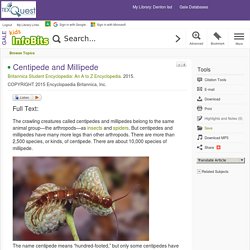
But centipedes and millipedes have many more legs than other arthropods. There are more than 2,500 species, or kinds, of centipede. There are about 10,000 species of millipede. The name centipede means “hundred-footed,” but only some centipedes have that many legs. Where Centipedes and Millipedes Live Centipedes and millipedes live all over the world, but they are most common in the tropics. Physical Features Centipedes and millipedes have long, thin bodies that are divided into segments, or sections. In a centipede, every body segment except the head and the rear has one pair of legs. Most kinds of centipedes and millipedes have only a few body segments when they hatch. Behavior Centipedes hide during the day and come out at night to hunt. Most types of millipedes eat rotting plant material. Badger: Kids Search - powered by EBSCOhost. Badger, name for several related members of the weasel family.
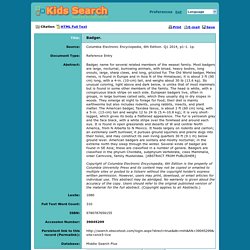
Most badgers are large, nocturnal, burrowing animals, with broad, heavy bodies, long snouts, large, sharp claws, and long, grizzled fur. The Old World badger, Meles meles, is found in Europe and in Asia N of the Himalayas; it is about 3 ft (90 cm) long, with a 4-in. (10-cm) tail, and weighs about 30 lb (13.6 kg). Its unusual coloring, light above and dark below, is unlike that of most mammals but is found in some other members of the family. The head is white, with a conspicuous black stripe on each side. European badgers live, often in groups, in large burrows called sets, which they usually dig in dry slopes in woods.
Badger Printout- EnchantedLearning.com. The badger is a burrowing mammal with a black-and-white striped face.
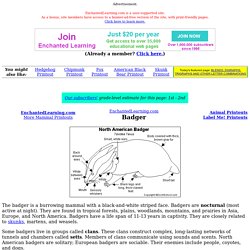
Badgers are nocturnal (most active at night). They are found in tropical forests, plains, woodlands, mountains, and prairies in Asia, Europe, and North America. Badgers have a life span of 11-13 years in captivity. Badger: EBSCOhost. Badger, common name for animals of the genera Meles and Taxidea.
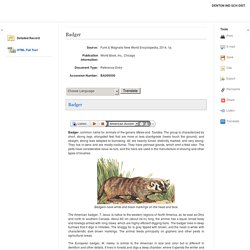
The group is characterized by short, strong legs, elongated feet that are more or less plantigrade (heels touch the ground), and straight, strong toes adapted to burrowing. Badger - Animal Facts. Badger (Taxidea Taxus) Badgers are found living in the forests of Europe and western Asia, scavenging for roots and berries as well as worms and insects.

Amazingly badgers can run up to 30km an hour for short periods of time and have been known to successfully fight off bigger mammals such as wolves, coyotes and bears! There have been occasional reports over the years of badgers being particularly aggressive towards dogs and even humans! The badger is capable of producing a painful bite, and some badgers are also known to carry a type of rabies.The most commonly known badgers are the white and black striped badgers in western Europe. Badgers are thought to be related to otters and weasels and can often grow to nearly a meter in length! The badger lives in underground burrows which often contains a maze of tunnels. Badger is the common name for any animal of the badger three subfamilies, which belong to the family Mustelidae. Badger - Animal Facts. Label Beetle Anatomy Printout. Advertisement.
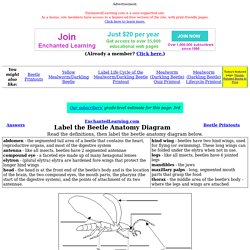
EnchantedLearning.com is a user-supported site. As a bonus, site members have access to a banner-ad-free version of the site, with print-friendly pages.Click here to learn more. (Already a member? Click here.) Read the definitions, then label the beetle anatomy diagram below. Beetle (Coleoptera) The beetle is a small sized invertebrate that is known to be incredibly versatile and is found in numerous different shapes and sizes.
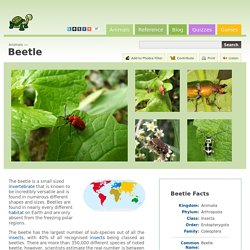
Beetles are found in nearly every different habitat on Earth and are only absent from the freezing polar regions. The beetle has the largest number of sub-species out of all the insects, with 40% of all recognised insects being classed as beetles. There are more than 350,000 different species of noted beetle, however, scientists estimate the real number is between 4 million and 8 million beetle species. As with other species of insects, the body of the beetle is comprised of three sections all coated in the hard outer shell, which are the head of the beetle, the thorax of the beetle and the abdomen of the beetle.
Beetles also have antennae which are used to understand the surroundings of the beetle and are made of about 10 different sections. Do you know beetles? Ranger Rick via EBSCO. Order Coleoptera: Beetles: Kids Search - powered by EBSCOhost. Beetles are the most abundant of all the insects.
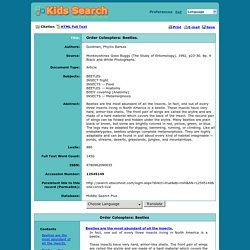
In fact, one out of every three insects living in North America is a beetle. These insects have very hard, armor-like shells. The front pair of wings are called the elytra and are made of a hard material which covers the back of the insect. The second pair of wings can be folded and hidden under the elytra.
Beetles are like a cross between an armored car and an airplane! Some beetles have mandibles or "pinchers" toothed on their inner edge (the word beetle comes from the Old English word "bitol" meaning "creature that bites"). Like all endopterygotes, beetles undergo complete metamorphosis (egg — larva — pupa — adult). Because beetles can be found in almost any environmental habitat, they have varied and diverse food appetites.
Beetle - Funk & Wagnalls New World Encyclopedia via EBSCOhost. Ferret: Kids Search - powered by EBSCOhost. Ferret, common name for Mustela putorius furo, a subspecies of the Polecat.
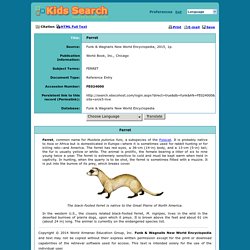
It is probably native to Asia or Africa but is domesticated in Europe—where it is sometimes used for rabbit hunting or for killing rats—and America. The ferret has red eyes, a 36-cm (14-in) body, and a 13-cm (5-in) tail; the fur is usually yellow or white. The animal is prolific, the female bearing a litter of six to nine young twice a year. The ferret is extremely sensitive to cold and must be kept warm when held in captivity.
Black-footed ferrets. Black-footed ferrets are small members of the weasel family.
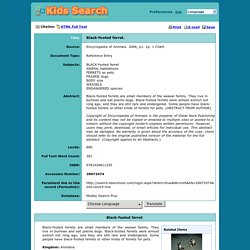
They live in burrows and eat prairie dogs. Black-footed ferrets were almost extinct not long ago, and they are still rare and endangered. Some people have black-footed ferrets or other kinds of ferrets for pets. Kingdom: Animalia Phylum: Chordata. Black-footed Ferret Printout- EnchantedLearning.com. Black-footed Ferrets are a type of weasel. An endangered species, these mammals used to roam over much of the prairies and grasslands of North America, but are exceedingly rare now. They are nocturnal (more active at night) and live in prairie dog burrows that they take over (usually after eating the prairie dogs). Anatomy: The Black-footed Ferret has very short legs, a long snout, and a slender body.
It is 1 1/2 feet (46 cm) long (from snout to tail). Diet: Ferrets are carnivores (meat-eaters). Ferret (Mustela Putorius Furo) The ferret is a domestic animal thought to be native to Europe. The ferret is thought to be a subspecies of polecat and the ferret has the same long shaped body as a polecat and a weasel. The ferret is thought to have been domesticated around 2,500 years ago, which is roughly the same time that a number of animals such as the donkey and goat were put to domestic use. The ferret is used to help farmers hunt out rabbits and the ferret does this by crawling into the rabbit burrows, with the ferret using its incredibly shaped flexible body to its advantage as a ferret is often small than many rabbits. The rabbit is scared out of the burrow by the invading ferret and uses one of the many burrow exits to get away from the ferret intruder.
Black-footed ferret. Region: North America. Kids InfoBits - Document - Ferrets. Full Text: A european ferret. . © Arco Images GmbH/Alamy. A ferret is a small mammal with a long body. Snake (Serpentes) There are around 2,700 known species of snake worldwide, with the snake being found on every continent apart from the polar regions, where it is too cold for the snake. The snake can grow anywhere from 10cm in length, to the enormous anaconda snake that can reach lengths of up to 30ft long! There are two ways that snakes kill their prey, either the snake has a poisonous bite or the snake will wrap itself around the prey to constrict it.
Most species of snake inhabiting colder regions in the Northern Hemisphere, will hibernate through the cold winter months. The snake tends to mate in the spring time. Snake Comments (23) Post Comment Article Tools. Bull Snake Printout- EnchantedLearning.com. Bull Snake via EBSCO. Coyote: Explora Primary Schools. Last reviewed: October 2014 Coyotes are very common members of the dog family. Since people have built houses on open lands in the United States, people have seen coyotes near their homes. EBSCO Publishing Service Selection Page. Last reviewed: January 2016. Eagle (Hieraatus Spilogaster) Eagle Printouts. Golden Eagle Printout- EnchantedLearning.com. Golden eagle: EBSCOhost. EAGLE EYE: EBSCOhost. Red fox: Explora Primary Schools. Fox: EBSCOhost. Red fox: EBSCOhost. Red Fox Printout- EnchantedLearning.com. The Red Fox, Vulpes vulpes, is a clever mammal that has large ears and a long, bushy tail. Red Fox - Animal Facts. Fox Facts.
Fox (Vulpes Vulpes) - Animals. Fox Location. Short-horned grasshopper: EBSCOhost. Funny fiddlers, hip hoppers, great gobblers. Grasshopper: EBSCOhost. Grasshopper (Caelifera) - Animals. Grasshopper Location Grasshopper The grasshopper is a medium to large sized insect and the grasshopper is found (close to grass) all over the world.
Grasshoppers are best known for their ability to jump incredible heights and distances. Grasshopper - Animal Facts. Grasshopper- Enchanted Learning Software. Advertisement. EnchantedLearning.com is a user-supported site. Hawk: EBSCOhost. Red-Tailed Hawk Printout- EnchantedLearning.com. Meadowlark: EBSCOhost. EBSCOhost Login. Western Meadowlark Printout- EnchantedLearning.com. Kids InfoBits - Document - meadowlark. Millipede: EBSCOhost. Millipede Printout. Millipede (Diplopoda) - Animals. Kids InfoBits - Document - millipede. EBSCOhost Login. EBSCOhost Login. EBSCOhost Login. Mockingbird Printout.
Mole Printout- EnchantedLearning.com. EBSCOhost Login. EBSCOhost Login. Butterfly Life Cycle Printout. Monarch Butterfly. Butterfly (Papilionoidea) - Animals. Monarch Picture Story. EBSCOhost Login. EBSCOhost Login. Kids InfoBits - Document - Monarch Butterflies. Mouse (Apodemus Sylvaticus) - Animals. Mouse Printout- EnchantedLearning.com. EBSCOhost Login. EBSCOhost Login. EBSCOhost Login. Gale - Enter Product Login. Virginia Opossum Printout- EnchantedLearning.com. Opossum (Didelphis Virginiana) - Animals. EBSCOhost Login. Kids InfoBits - Document - Opossums. Great Horned Owl - Animal Facts. Great Horned Owl Printout- EnchantedLearning.com. Great Horned Owl. Owl: EBSCOhost. EBSCOhost Login.
EBSCOhost Login. Prairie dogs: Explora Primary Schools. Prairie Dog Printout- EnchantedLearning.com. EBSCOhost Login. EBSCOhost Login. EBSCOhost Login. Rabbit Printout- EnchantedLearning.com. Rabbit (Oryctolagus Cuniculus) - Animals. Jackrabbit - Animal Facts. Jack Rabbit Printout- EnchantedLearning.com. EBSCOhost Login. EBSCOhost Login. EBSCOhost Login. Rabbit Facts. Raccoon (Procyon Lotor) - Animals. Raccoon Printout- EnchantedLearning.com. Raccoon - Animal Facts. Raccoon Facts. EBSCOhost Login. Kids InfoBits - Document - Raccoons.